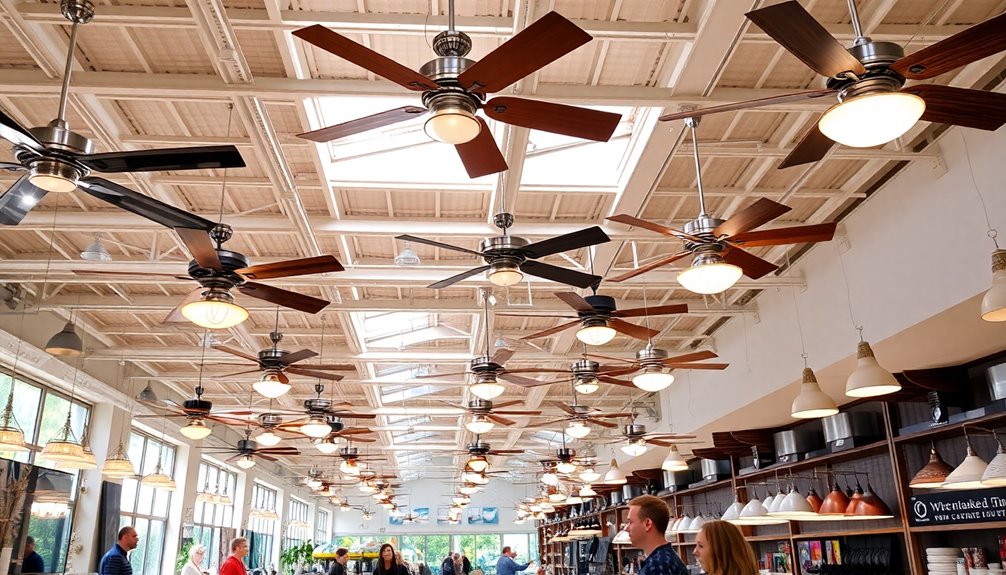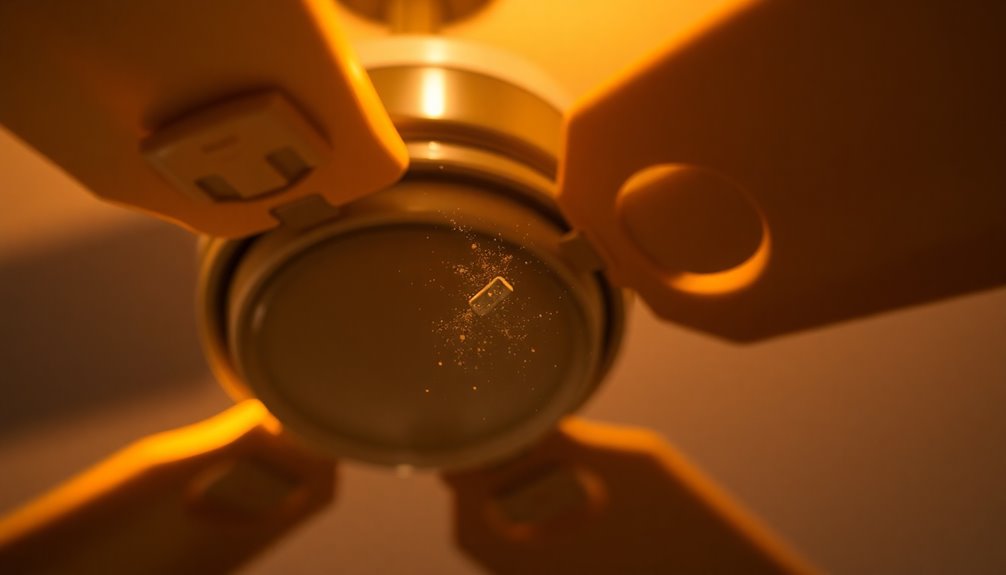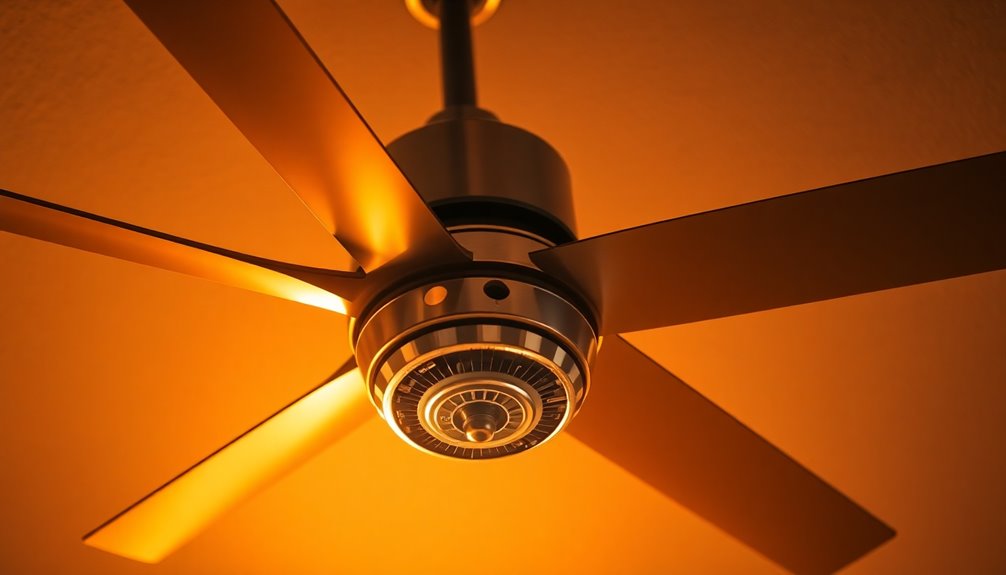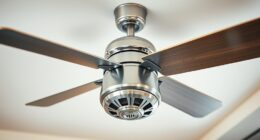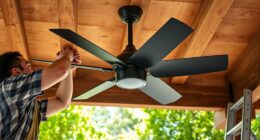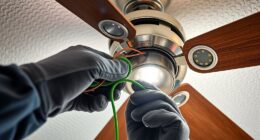Yes, a wobbly ceiling fan can fall off, and it's a serious risk you shouldn't ignore. Wobbling often indicates loose connections or improper installation, which can lead to dangerous accidents. Signs like excessive wobbling, unusual noises, or visible damage should prompt immediate action. Regular inspections and maintenance are essential for ensuring your fan's stability and safety. If your fan wobbles persistently despite your efforts, it might be time for professional assessment. Keeping a close eye on these issues will help prevent accidents, and there are more tips on maintaining your fan's safety and performance you might find useful.
Key Takeaways
- A wobbly ceiling fan can pose serious safety risks, including the potential for it to fall if components are loose.
- Excessive wobbling (greater than 1/8-inch) may indicate loose mounting brackets that compromise stability and increase fall hazards.
- Regular inspections can identify issues like loose connections or damaged components that could lead to the fan detaching.
- If unusual noises accompany wobbling, it signals potential serious problems that could result in the fan falling.
- Proper installation and maintenance are crucial to prevent wobbling and ensure the fan remains securely mounted to avoid accidents.
Understanding Ceiling Fan Wobbling

Ceiling fan wobbling is a common issue that can disrupt your comfort and raise safety concerns. When you notice a wobbly ceiling fan, it's often due to misaligned blades, bent blade arms, or warped blades. These factors can throw off the fan's balance, leading to an uncomfortable experience and potential hazards.
If the wobble exceeds 1/8-inch, it could signal that components may loosen over time, posing a risk to safety. Regular maintenance and inspections are essential in identifying and correcting these wobbling issues.
Don't ignore the signs; addressing fan wobbling promptly can prevent further damage to the fan and its mounting system. It's important to understand that extreme wobbling generally stems from misaligned blades rather than loose mounting. This means your fan is likely secured, but that doesn't lessen the significance of resolving the wobble.
Causes of Wobbling Fans

When a fan starts to wobble, it's usually due to several common culprits. Understanding the causes of wobbling fans can help you troubleshoot the issue effectively.
Here are four main reasons your fan might be unsteady:
- Bent Blade Irons: If the blade irons are bent, it disrupts the fan's balance and stability, causing a wobbly fan during operation.
- Warped or Damaged Blades: Warped blades lead to uneven airflow, which can greatly contribute to wobbling. Even small damages can have an outsized impact.
- Inconsistent Blade Sizes or Weights: Using blades of different sizes or weights creates imbalances that result in excessive fan wobbling. Ensuring uniformity is key.
- Loose Blade Connections: If the blade connections are loose or unsecured, they may shift during rotation, leading to instability and wobbling.
Additionally, if the mounting bracket or hanger ball is misaligned, it can also cause wobbling.
Safety Risks of a Wobbly Fan

A wobbly ceiling fan can be a serious safety hazard in your home.
If it's not properly installed or balanced, it might detach, leading to potential injuries from falling parts or the fan itself.
Regular maintenance and proper installation are key to ensuring your fan stays secure and safe to use.
Potential Injury Hazards
Wobbly ceiling fans can create considerable safety risks, especially for children who may not recognize the dangers they pose. The potential for injury is real, with reports of serious accidents, including skull fractures, due to malfunctioning fans.
Here are a few key hazards you should be aware of:
- Loose Mounting: A wobbly fan may have loose mounting systems that can come loose over time, increasing the risk of falls.
- Blade Misalignment: Noticeable wobbling can result from misaligned blades, which can lead to unpredictable movements and potential injury.
- Falling Debris: If a fan's components become detached, they can fall and injure anyone underneath, particularly children who might be playing nearby.
- Neglected Maintenance: Regular inspections are essential. Unchecked wobbling can lead to accidents, putting everyone at risk.
Awareness of these injury hazards is vital. By ensuring proper installation and conducting regular maintenance, you can greatly reduce the likelihood of injury from a wobbly ceiling fan. Additionally, regular maintenance can help prevent dangerous situations caused by mechanical failures or loose components.
Prioritizing safety will help protect your loved ones from the dangers associated with these common household fixtures.
Installation Stability Issues
Often, homeowners overlook installation stability issues that can lead to a wobbly ceiling fan. Loose mounting brackets or connections greatly compromise the fan's stability, increasing the risk of it falling. If you notice the wobbling exceeds 1/8-inch, it's vital to act quickly. Heavy ceiling fans require robust support from mounting brackets, so ensuring a secure installation is critical. Regular maintenance, similar to the upkeep required for heat pump systems, can significantly enhance the safety and longevity of your ceiling fan. Additionally, ensuring that the fan is installed on a secure mounting surface can further prevent stability issues.
Regularly inspecting for loose screws and connections can prevent accidents related to falling fans. While extreme wobbling rarely results in a fan falling, it can cause light covers to detach and create noise, signaling the need for immediate maintenance.
Here's a quick reference table to help you understand the risks and solutions:
| Issue | Risk | Solution |
|---|---|---|
| Loose mounting brackets | Increased wobbling and risk | Tighten all screws and bolts |
| Wobbling exceeds 1/8-inch | Potential fan fall | Use a ceiling fan balancing kit |
| Neglected inspections | Accidents and injuries | Schedule regular checks
Inspection and Maintenance Tips

To keep your ceiling fan safe and functional, you should conduct regular visual inspections.
Check for loose components and tighten any screws as needed to guarantee everything's secure.
Balancing the fan blades is also essential for smooth operation and to prevent wobbling.
Regular Visual Inspections
Regular visual inspections of your ceiling fan are vital for guaranteeing safety and performance. By taking a few moments to check your fan regularly, you can identify any loose components and prevent potential hazards before they escalate.
Here are four key areas to focus on during your inspections:
- Canopy and Mounting Bracket: Check that the canopy and mounting bracket are securely fastened to the ceiling. Look for any signs of wear or damage.
- Hanger Ball: Confirm the hanger ball is properly seated in the mounting bracket. This is essential for stability.
- Electrical Box: Verify that the electrical box is rated for fan use. This will help avoid electrical issues down the line.
- Screws and Fasteners: Regularly inspect all screws and fasteners for tightness. Loose components can lead to wobbling and potential accidents.
Tightening Loose Components
After completing a thorough visual inspection, the next step is tightening any loose components. Regularly check your fan's screws and connections to verify they're secure. Loose components can lead to wobbling and even potential hazards. Use a ladder to reach the fan and gently tug on the mounting bracket; if it moves, you'll need to tighten it further.
Don't forget to check the canopy cover and confirm it's fastened securely. A loose canopy can compromise the fan's stability during operation. Also, periodically monitor the hanger ball and downrod support screws for tightness. These parts are essential for keeping everything in place.
To help you keep track of your maintenance, here's a simple checklist:
| Component | Action Required |
|---|---|
| Mounting Bracket | Tighten if loose |
| Canopy Cover | Securely fasten |
| Hanger Ball | Check for tightness |
| Downrod Support Screws | Verify they're tight |
| Document Maintenance | Keep a record of repairs |
Balancing Fan Blades
Balancing fan blades is essential for maintaining a safe and efficient ceiling fan. If your ceiling fan blades are uneven, you might face wobbling, leading to potential safety hazards.
Here are some inspection and maintenance tips to help you fix a wobbly ceiling:
- Inspect for Damage: Regularly check the blades for wear or warping. Damaged blades can exacerbate wobbling.
- Adjust Mounting Screws: Confirm that the screws in the motor housing are tightened. Proper alignment reduces wobbling risks.
- Use a Balancing Kit: Invest in a balancing kit, which usually includes a plastic clip and weights. This helps identify uneven blade weights and corrects them.
- Measure Blade Height: Measure the vertical distance from the ceiling to the tips of each blade. A difference greater than 1/8-inch can indicate an imbalance.
How to Balance Your Ceiling Fan

If your ceiling fan wobbles during operation, it's crucial to address the issue for both safety and comfort. Start by using a weighted clip from a balancing kit; attach it to the middle of a fan blade to pinpoint where the wobbling occurs. Shift the clip between different blades and adjust its position along the length of the problematic blade until the wobble ceases.
Next, check that each blade is evenly spaced from the ceiling, ideally 8-10 inches apart. Uneven heights can contribute to imbalance, so verify they're all aligned. If you notice any loose screws on the blade arms, tighten them up, as loose components can cause instability.
Also, inspect the blades for any bends or warps, which can greatly affect the fan's overall balance.
Once you've eliminated the wobble, secure the weight in place with adhesive to maintain that balance during operation. By following these steps, you'll not only enhance the performance of your ceiling fan but also create a safer environment in your home.
A well-balanced fan operates quietly and efficiently, providing the comfort you desire.
When to Seek Professional Help

If your ceiling fan wobbles persistently despite your adjustments, it's time to contemplate professional help.
Signs like unusual noises, sparks, or visible damage shouldn't be ignored, as they can indicate serious issues.
Don't hesitate to call in an expert if you're unsure about the repair process or if your fan is over ten years old.
Signs of Serious Issues
A wobbly ceiling fan can be more than just an annoyance; it can signal serious safety issues that require immediate attention.
If you notice any of the following signs, it's time to seek professional help:
- Excessive Wobbles: If your fan wobbles more than 1/8-inch, it could indicate potential safety risks and needs evaluation.
- Noisy Operation: Unusual sounds during operation might point to mechanical failures, making it essential to consult a technician.
- Visible Damage: Look for any visible cracks or breaks in the fan; these can compromise its integrity and require expert assessment.
- Loose Electrical Boxes: If you suspect your electrical box is loose, that's a serious issue that shouldn't be ignored.
Additionally, if you're still experiencing persistent wobbling despite balancing attempts, it may suggest deeper structural or mounting problems needing immediate attention.
Also, if your fan is over 10 years old, it likely has mechanical issues that warrant a professional inspection to avoid potential hazards.
Don't take chances with your safety; addressing these signs promptly can prevent accidents.
Professional Repair Recommendations
Persistent wobbling in your ceiling fan isn't just annoying; it can signal deeper issues that require professional help. If you've tried balancing the fan and the wobbling continues, it might be time for a professional assessment.
Structural problems, such as loose electrical boxes, can cause safety hazards and must be addressed by a qualified electrician.
If your fan is over ten years old and shows signs of wobbling or unusual noises, consulting a professional for a thorough inspection is advisable. They can determine if the fan needs repairs or replacement.
Be vigilant about warning signs like visible damage, sparks, or strange sounds—these should prompt immediate professional evaluation to prevent hazardous situations.
Regular maintenance checks by professionals can catch issues early, ensuring safe operation and potentially extending your fan's lifespan. Ignoring persistent wobbling or other warning signs can lead to significant problems down the line.
Don't hesitate to reach out to an expert when in doubt; your safety and comfort are worth it. Remember, when it comes to ceiling fans, it's always better to be safe than sorry.
Signs Your Fan Needs Replacement

Sometimes, a ceiling fan might show signs that it's time for a replacement.
If you notice any of the following issues, it's best to contemplate replacing your fan to guarantee safety and functionality:
- Excessive Wobbles: If your fan wobbles more than 1/8-inch, it could indicate structural problems that may lead to failure or even falling.
- Unusual Noises: Grinding or rattling sounds often signal wear and tear on components. Don't ignore these noises; they might necessitate a replacement.
- Age Matters: Fans older than 10 years are prone to mechanical failures. If yours shows instability or poor performance, it's time to evaluate for replacement.
- Inconsistent Speeds: If your fan consistently slows down or struggles to operate at different speeds, it might've electrical or mechanical issues that warrant a replacement.
Recognizing these signs early can help you avoid hazardous situations.
Don't wait until it's too late—if your ceiling fan displays any of these issues, it's time to replace it for your safety.
Preventing Future Wobbling Issues

Replacing a wobbly ceiling fan can be a hassle, but taking steps to prevent wobbling issues in the first place is far easier. Start by regularly inspecting and tightening all screws and connections on your ceiling fan. This helps guarantee stability during operation and minimizes the chances of wobbles.
It's also essential to measure the distance from the ceiling to the tips of the fan blades; you should maintain an ideal clearance of 8-10 inches for better performance.
Using a balancing kit with weighted clips can be a game-changer. This kit helps you identify and correct any imbalances among the blades, greatly reducing wobbling.
Furthermore, make certain your fan is mounted on a fan-rated electrical box that can support its weight. Improper support can contribute to instability and wobbles.
Lastly, perform routine maintenance checks at least once a year. Look for signs of wear, loose screws, or misalignment, as these can lead to future wobbling issues.
Ceiling Fan Installation Best Practices

When installing a ceiling fan, it's crucial to set it up correctly to guarantee safety and peak performance. Follow these best practices to verify a secure installation:
- Use a fan-rated electrical box: Make certain your ceiling fan is mounted on a fan-rated electrical box that can support its weight. This prevents any risk of falling. Additionally, ensuring the box is weather-resistant can be particularly important for outdoor installations.
- Choose the right downrod length: Maintain a distance of 8-10 inches between the fan blades and the ceiling. This distance optimizes airflow and stability.
- Inspect mounting hardware regularly: Regularly check and tighten all mounting hardware, including screws and bolts. Loose components can contribute to wobbling and potential hazards.
- Follow manufacturer's instructions: Each fan model may have specific requirements for installation. Adhering to these guidelines verifies safe mounting.
If you're unsure about the structural integrity of your ceiling or the proper assembly of the fan components, consider consulting a professional. Additionally, ensuring a secure installation can help reduce the risk of potential losses from theft, as a well-installed fan is less likely to cause accidents that could lead to damage or injury.
Proper ceiling fan installation not only enhances performance but also minimizes safety risks.
Benefits of Regular Maintenance

Regular maintenance of your ceiling fan is vital, as it not only guarantees peak performance but also greatly enhances safety in your home. By routinely checking for loose screws and connections, you can prevent wobbling that might lead to potential safety hazards or falls.
A well-maintained fan operates more efficiently, which means cooler air during hot months and reduced energy costs. In fact, just like energy-efficient heat pumps, ceiling fans are designed to optimize energy use and enhance comfort. Additionally, ensuring that the fan's motor is well-lubricated can further improve system efficiency, leading to even greater energy savings. Regularly cleaning the fan can also prevent dust accumulation, which is crucial for maintaining optimal performance and air quality. Furthermore, good oral hygiene habits can positively influence overall health, similar to how a clean ceiling fan contributes to a healthier living environment.
Cleaning the fan blades and inspecting them for damage is another important aspect of maintenance. Dust buildup can hinder performance, while damaged blades may pose risks.
Additionally, tightening mounting brackets guarantees the fan is securely attached to the ceiling, further minimizing the risk of detachment.
Scheduling periodic professional inspections can help identify structural issues early, reducing the likelihood of accidents associated with fan instability. Regular maintenance can also improve indoor air quality, ensuring a healthier living environment for your home.
Regular maintenance not only enhances operational effectiveness but also creates a safer environment, considerably lowering the risk of injury from falling components.
Incorporating these practices into your routine will extend the lifespan of your ceiling fan, keeping your home comfortable and safe.
Don't overlook the importance of regular maintenance; it's a small effort that yields substantial benefits.
Frequently Asked Questions
Can a Wobbly Ceiling Fan Possibly Fall?
Yes, a wobbly ceiling fan can possibly fall, especially if the wobbling is excessive.
While it's generally unlikely, continuous wobbling can loosen the mounting over time.
If you notice your fan wobbling more than 1/8-inch, it's vital to address the issue.
Regular maintenance, like tightening screws and checking the mounting, can keep your fan stable and safe.
Don't ignore it; taking action now can prevent potential hazards later.
How Likely Will a Ceiling Fan Fall?
When you consider how likely a ceiling fan will fall, it's crucial to focus on proper installation and maintenance.
If the fan's securely mounted and regularly checked, the risk of it falling is quite low. Most falls happen due to improper installation or loose brackets, not from normal wobbling.
To keep your fan safe, verify it's installed correctly and address any wobbling issues promptly. Regular inspections can make a significant difference in safety.
Is It Safe for a Ceiling Fan to Wobble?
It's not ideal for a ceiling fan to wobble. While minor wobbles are common, excessive wobbling can signal underlying issues that may need your attention.
You should check for loose screws or improper installation if you notice significant movement. Regular maintenance can help keep your fan secure and functioning smoothly.
Staying aware of unusual noises or extreme wobbles will help you prevent potential safety hazards in your home.
How Do You Know if a Fan Is Going to Fall?
To know if your fan might fall, watch for signs like excessive wobbling, loose screws, or a misaligned canopy.
If you hear unusual noises or notice frayed wiring, those are red flags too.
Check that the mounting bracket is secure and compatible with your ceiling.
Regularly inspect these components to guarantee everything's tight and stable.
If issues persist, it's best to consult a professional before risking a potential fall.
Conclusion
In summary, a wobbly ceiling fan can pose safety risks, with around 50,000 injuries occurring each year due to ceiling fan-related accidents. Regular maintenance and proper installation are key to preventing these issues. By balancing your fan and checking for loose parts, you can keep it safe and functional. Remember, taking a few minutes for routine inspections can save you from potential hazards and guarantee your fan runs smoothly for years to come.



